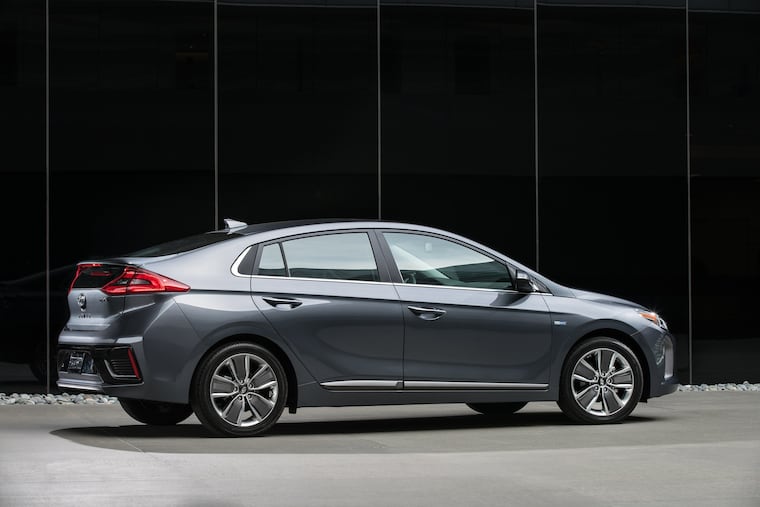Hyundai Ioniq Hybrid retains its attractive charge
The 2019 Hyundai Ioniq Hybrid continues its tradition of efficiency with just a bit of fun. There's not a lot of space, but the entry price makes it worthwhile.

2019 Hyundai Ioniq Hybrid SEL: Just as good the second time around?
Price: $25,960 as tested. Just $125 for carpeted floor mats.
Marketer’s pitch: “Safe, savvy and premium.”
Conventional wisdom: Car and Driver likes the “affordable pricing, generous standard equipment, excellent efficiency,” but not that the EV is "only sold in select states, plug-in hybrid needs a stronger electric motor, refinement could be better.”
Reality: Even better, really.
Too good to be true? Sometimes Mr. Driver’s Seat remembers a car review so surprisingly positive (the Lovely Mrs. Passenger Seat: “Yes, it’s always a surprise when he’s not complaining”) that I’m almost afraid to get the car the next time. Maybe I was in a really good mood that week or something, and will have to walk back everything I wrote, and put my curmudgeon hat back on.
That trepidation gnawed at me as the Ioniq landed on my schedule. I christened the 2017 Ioniq as “beating Toyota at its own game.”
The good news — after trying the 2019 model, I now can add that it’s more than simply “better than a Prius.” (A slightly new grille and some interior enhancements will be the only change for 2020.)
Fuel economy: But first, here’s what you really want to know about the Ioniq. The small hybrid hatchback — a plug-in hybrid and electric model round out the lineup — averaged 51 mpg in a rather raucous week of driving. I could have pushed the numbers even higher if I had babied the accelerator, so your mileage may vary. But Mr. Driver’s Seat has places to go, so I need to get there quickly, economy be damned.
Up to speed: The addition of a Sport mode to a small hybrid hatchback unleashes a whole different kind of car. You can putt-putt along and save fuel, but move that lever to the left and the power is surprising. You’ll see 60 mph in as (relatively) fast as 9.6 seconds (obviously you’re not going to have to brace your neck), according to Motor Week. This acceleration comes thanks to the combined 139 horsepower from the 1.6-liter four-cylinder and the 32-kilowatt motor.
On the road: Even better, the little Ioniq bops around with the best of the small cars. Winding country roads are kind of fun, although the tiny car does tilt a lot for my liking.
Most surprising are the Ioniq’s highway manners. I-95 and Route 202 pose no challenge for the Ioniq, as the car keeps up with traffic and doesn’t smash into road seams.
And for a couple of days, I thought perhaps I looked a little funny racing around traffic in my white test vehicle, until I noticed a red model go sailing past me near the airport. Regular readers know that anyone sailing past Mr. Driver’s Seat is going pretty darn fast. Well, yeehaw.
Shifty: The Ioniq hangs on to its 6-speed dual clutch transmission as well, an unusual feature to behold in a hybrid, which mostly use CVTs. It can be a little abrupt, and the powertrain had a few dicey moments on chilly mornings, but just for a few moments at the start.
Driver’s Seat: The heated cloth seat functioned well, although I didn’t get a chance to test it because the weather was warm in October. The seat was supportive and firm, with a nice bolster, but it may be a little hard for some folks. I felt a twinge in my back that week but couldn’t pinpoint it to the seat itself — I’m not getting any younger — but it’s just something you may want to watch for.
Friends and stuff: The rear seat itself is comfortable enough, especially for an economy car, but the compact Ioniq is not exactly roomy. Legroom and foot room are snug, and headroom is pretty tight. Duck your head when entering or expect the Ioniq to leave a mark.
Hyundai claims cargo space of 26.5 cubic feet but doesn’t mention whether the rear seat is folded or not.
Play some tunes: The 7-inch touchscreen audio system is typical Hyundai, with a clear touchscreen and plenty of buttons to help drivers navigate easily from function to function. Dials handle volume and tuning. Adjusting the sound setup can be a little cumbersome, though.
The sound itself is not bad, probably an A-.
Keeping warm and cool: I found the Ioniq HVAC to be easy to operate, with dials for temperature and buttons for everything else — although all dials would improve that even further. But I found getting the temperature right to be a challenge. Whether or not it was in automatic mode, it seems hard to get it to cool quickly on hot days and warm quickly on cool days.
Where it’s built: Ulsan, South Korea.
How it’s built: Consumer Reports gives the 2020 Ioniq a predicted reliability of 4 out of 5.
In the end: The little Ioniq still gives Mr. Driver’s Seat a charge.